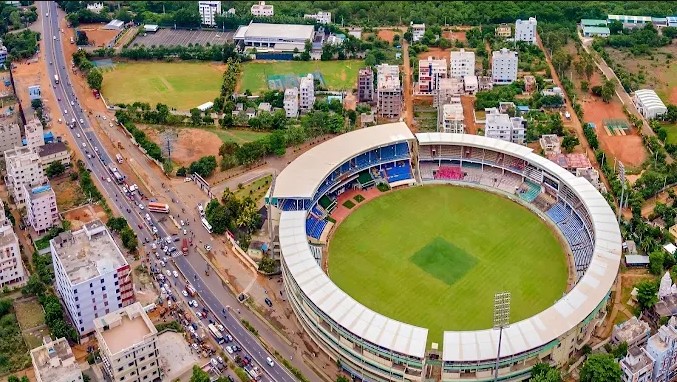Visakhapatnam Stadium: The ACA–VDCA Cricket Stadium, officially known as Dr. Y.S. Rajasekhara Reddy ACA–VDCA Cricket Stadium, is located in Visakhapatnam, Andhra Pradesh. Known for its picturesque setting and sea breeze-influenced conditions, the stadium has emerged as one of India’s key cricketing venues. While fans often focus on pitch behavior or team strategy, one often-overlooked factor that deeply influences a match’s outcome is the boundary length.
Table of Contents
Visakhapatnam Stadium: In cricket, the size and shape of boundaries can greatly affect scoring rates, bowling strategies, and even fielding placements. In this article, we’ll examine the boundary dimensions at ACA–VDCA across formats, their impact on gameplay, and how they compare with other stadiums in India.
Overview of ACA–VDCA Stadium
| Feature | Details |
|---|---|
| Location | Visakhapatnam, Andhra Pradesh, India |
| Established | 2003 |
| Capacity | ~27,500 spectators |
| First International Match | ODI in 2005 (India vs Pakistan) |
| Home Team | Andhra Pradesh (Domestic), India (Intl.) |
Visakhapatnam Stadium: The stadium’s boundary lengths are not uniform due to the oval-shaped outfield. This results in a range of distances from the pitch to the boundary rope depending on the direction.
Boundary Lengths: Direction-Wise Dimensions
Though boundary sizes can be adjusted slightly depending on the match format, advertising boards, and camera placements, here are typical ranges:
| Direction | Average Length (Meters) |
|---|---|
| Straight (Down the Ground) | 74 – 78 m |
| Square (Offside) | 63 – 67 m |
| Square (Leg side) | 61 – 65 m |
| Behind the Wicket (Fine leg/Third man) | 60 – 64 m |
Visakhapatnam Stadium: These values are approximate, as the International Cricket Council (ICC) allows a certain degree of flexibility, especially in shorter formats.
Format-Wise Boundary Adjustments
Visakhapatnam Stadium: Modern cricket often tailors boundary dimensions to suit the entertainment needs of the format. T20s tend to favor smaller boundaries for more sixes, while Tests maintain larger sizes for a traditional, strategic contest.
T20 Internationals
| Boundary Type | Approx. Length (Meters) |
|---|---|
| Straight | 72 – 75 m |
| Square Boundaries | 60 – 63 m |
| Behind the Wicket | 58 – 62 m |
Impact: Expect more sixes, especially square of the wicket. Bowlers often resort to variations like slower balls and wide yorkers to compensate for the shorter ropes.
➤ One-Day Internationals (ODIs)
ODIs strike a middle ground between T20 flair and Test patience. Boundaries are slightly extended to balance aggression with technical skill.
| Boundary Type | Approx. Length (Meters) |
|---|---|
| Straight | 74 – 78 m |
| Square Boundaries | 62 – 66 m |
| Behind the Wicket | 60 – 64 m |
Impact: Batsmen still take aerial routes, but timing and placement become more critical. Bowlers focus on tighter lines and intelligent field placements.
➤ Test Matches
The longest format sticks to maximum legal boundary distances as per ICC regulations (not less than 59.43 meters from the center of the pitch to the boundary).
| Boundary Type | Approx. Length (Meters) |
|---|---|
| Straight | 77 – 80 m |
| Square Boundaries | 66 – 69 m |
| Behind the Wicket | 62 – 66 m |
Effect on Gameplay Strategies
Batsmen’s Perspective
- T20s: Target shorter square boundaries; play riskier shots like ramps and scoops.
- ODIs: Balance risk and reward; place shots carefully, especially when mid-sized boundaries are used.
- Tests: Timing and shot selection are more vital than power; running between wickets matters more.
Bowlers’ Perspective
- T20s: Must adapt with deceptive deliveries—slower balls, cutters, and yorkers.
- ODIs: Utilize boundary size to bowl to field settings (e.g., bowl wide to bigger side of boundary).
- Tests: Exploit longer boundaries by inducing aerial strokes from batters who are trying to force the pace.
Comparative Table: ACA–VDCA vs Other Indian Grounds
| Stadium | Straight (m) | Square (m) | Behind Wicket (m) |
|---|---|---|---|
| ACA–VDCA (Visakhapatnam) | 74 – 78 | 61 – 67 | 60 – 64 |
| Wankhede (Mumbai) | 70 – 74 | 60 – 65 | 58 – 62 |
| Eden Gardens (Kolkata) | 73 – 77 | 64 – 68 | 61 – 65 |
| Narendra Modi Stadium (Ahmedabad) | 77 – 82 | 66 – 70 | 62 – 68 |
Key Takeaways
- Balanced Boundaries: ACA–VDCA is not a “small ground” like some others (e.g., Chinnaswamy Stadium). The mix of long straight boundaries and moderately short square ones makes it tactically interesting.
- Wind Influence: The coastal breeze in Visakhapatnam can affect how far the ball travels, especially in day-night games. Players are known to aim for shots downwind when possible.
- Pitch and Ground Synergy: The stadium often provides spin-friendly pitches, so boundaries become even more crucial. Batters must choose gaps wisely and play with soft hands to rotate the strike.
The ACA–VDCA Cricket Stadium in Visakhapatnam, with its thoughtfully planned boundary lengths, exemplifies how ground dimensions can shape the tempo and tactics of cricket matches. Whether it’s a whirlwind T20 chase or a tense Test match battle, the boundary ropes play a silent but significant role in determining outcomes.
As modern cricket continues to evolve, so will stadium designs and dimensions. But at ACA–VDCA, the current setup strikes a perfect balance between bat and ball, making every match a strategic chessboard under the Vizag sky.


